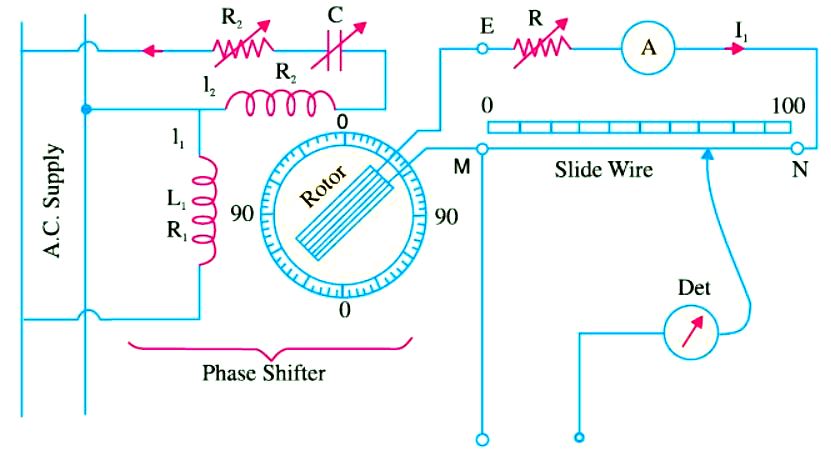AC Potentiometer
An AC potentiometer basically works on the same principle as a DC potentiometer. However, there is one very important difference between the two. In DC potentiometer, only the magnitudes of the unknown e.m.f. and slide-wire voltage drop are made equal for obtaining balance. But in an AC potentiometer, not only the magnitudes but phases as well have to be equal for obtaining balance. Moreover, to avoid frequency and waveform errors, the A.C. supply for slide-wire must be taken from same source as the voltage or current to be measured.
AC potentiometers are of two general types differing in the manner in which the value of the unknown voltage is presented by the instrument dials or scales. The two types are :
(i) Polar potentiometers in which the unknown voltage is measured in polar form i.e. in terms of magnitude and relative phase.
(ii) Co-ordinate potentiometers which measure the rectangular co-ordinates of the voltage under test.
Drysdale Polar AC Potentiometer
As shown in Figure (A) for A.C. measurements, the slide-wire MN is supplied from a phase shifting circuit so arranged that magnitude of the voltage supplied by it remains constant while its phase can be varied through 360°.

Consequently, slide-wire current I can be maintained constant in magnitude but varied in phase. The phase-shifting circuit consists of :
- Two stator coils supplied from the same source in parallel. Their currents I1 and I2 are made to differ by 90° by using well-known phase-splitting technique.
- The two windings produce a rotating flux which induces a secondary e.m.f. in the rotor winding which is of constant magnitude but the phase of which can be varied by rotating the rotor in any position either manually or otherwise. The phase of the rotor e.m.f. is read from the circular graduated dial provided for the purpose.
The ammeter A in the slide-wire circuit is of electrodynamic of thermal type. Before using it for A.C. measurements, the potentiometer is first calibrated by using D.C. supply for slide wire and a standard cell for test terminals T1 and T2. The unknown alternating voltage to be measured is applied across test terminals I2 and T2 balance is effected by the alternate adjustment of the slide-wire contact and the position of phase-shifting rotor. The slide-wire reading represents the magnitude of the test voltage phase-shifter reading gives its phase with reference to an arbitrary reference vector.
AdBlock-2
Gall Co-ordinate Potentiometer
This potentiometer uses two slide-wires CD and MN with their currents I1 and I2 (Figure (B)) having a mutual phase difference of 90°. The two currents are obtained from the single phase supply through isolating transformers, the circuit for ‘quadrature’ slide wire MN incorporating a phase shifting arrangement.

Before use, then current I1 is first standardised as described for Drysdale potentiometer. Next, current I2 is standardised with the help of the mutually induced e.m.f. E in inductometer secondary. This e.m.f. E = ω MI1 and is in quadrature phase with I1. Now, E is balanced against the voltage drop on slide-wire MN. This balance will be obtained only when I2 is of correct magnitude and is in exact quadrature with I1. Balance is achieved with the help of the phase-shifter and rheostat R2.
The unknown voltage is applied across the test terminals T1 and T2. Slide-wire MN measures that component of the unknown voltage which is in phase with I2. Similarly, slide-wire CD measures that component of the unknown voltage which is in phase with I1. Since I1 and I2 are in quadrature, the two measured values are quadrature components of the unknown voltage. If V1 and V2 are these values, then
![]()
Reversing switches S1 and S2 are used for measuring both positive and negative in-phase and quadrature components of the unknown-voltage.
Read article – DC potentiometer
Visit NCERTplanet.com for NCERT solutions and Textbook downloads




